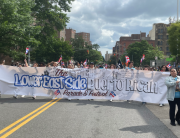Artificial hair integrations, more commonly known as hair extensions or hair weaves, add length and fullness to human hair. Hair extensions are usually clipped, glued, or sewn on natural hair by incorporating additional human or synthetic hair. These methods include tape-in extensions, clip-in or clip-on extensions, fusion method, weaving method, and wigs. A hair weave is human or artificial hair utilized for the integration with one’s natural hair.
The misnomer of ‘tracks’ comes from the common, long-lasting method of integrating wefts, known as the ‘track and sew’ method. The ‘tracks’ are usually cornrows, braided in the direction of how the hair will fall. Toward the face or away, with or without a part, the tracks build the foundation of how the end result will look. The wefts are then sewn onto the braids, usually with a specially made, blunt-ended needle. The needle can be curved or straight. There are many different colors of specially-made thread to choose from, depending on what color of hair you will be integrating. Darker hair lends to darker thread. When the hair is braided at a high level of tension, the client is at risk for traction alopecia.
Wefts may also be bonded directly to the clients hair using special bonding glue. Care must be taken not to bond the wefts directly to the scalp, as it can cause sensitivities in some clients. A patch test is frequently recommended, as per manufacturer’s directions. Glue has become less popular since it was discovered that glue can cause severe and often permanent health issues such as headaches, bald spots and dermatitis.
The “invisible part” is a technique used by hair stylists that hides any evidence that the person is wearing an extension. The extension will appear as if it is growing directly from the person’s scalp. This look can be achieved with either the sew-in or glue method.This technique allows a long lasting method of attaching commercial hair to the natural hair. Application generally takes about an hour. It will last about 8 weeks.Bulk hair can also be bonded to the hair, using many different methods, from clips to adhesive.
In the South East Asian Region, the practical method of lengthening-re-bondage has been in use since the mid-19th century. The lengthening-re-bondage method consists of two treatments. The first treatment consists of re bonding and ironing. The second treatment of lengthening-re bondage involves gentle pulling and tugging of the hair. These two treatments are highly effective in lengthening hair without causing serious damage.Bulk hair can also be added with thread if bonding is not suitable. This may be because the wearer has excessively oily hair or because there is a need to wash hair daily. Adding hair extensions with thread means that damage to the natural hair can be avoided and that the hair extension attachment areas are not vulnerable to external elements like heat, oils and water.







Add Comment
You must be logged in to post a comment.